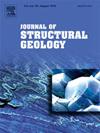Exploring spatial heterogeneity and topological properties of fracture Networks: A statistical characterization
IF 2.9
2区 地球科学
Q2 GEOSCIENCES, MULTIDISCIPLINARY
引用次数: 0
Abstract
Analyzing fracture patterns and estimating their topological and spatial properties are essential for the predictive stochastic modelling of fractured rocks. In this study, we examined 83 natural fracture patterns compiled from existing literatures, covering diverse geological settings. To investigate spatial clustering in two dimensions (2D), we employed a multiscale spatial statistical parameter ‘Lacunarity’ which quantifies textural heterogeneity. Unlike previous studies that focused solely on the clustering of two-dimensional fracture arrays, our analysis also considers the spatial clustering of topological nodes—specifically, intersection and end-tip points within fracture networks.
Our findings indicate that the spatial distribution of nodes within a fracture network follows a non-random pattern. As fracture arrays become more clustered, the clustering of nodes also intensifies. With an increase in clustering of fracture arrays, the mean branch length weakly reduces owing to the proliferation of smaller branches within the network. Moreover, we noted that the clustering of fracture array has little correlation with the topological connectivity of the fracture networks. This is because topological connectivity only considers the abundance of different types of nodes within a pattern, without considering their spatial distribution. Finally, leveraging the estimated topological and spatial properties of the analyzed fracture patterns, we have proposed a statistical model, which would be useful to modellers and engineers involved in research on the circulation of any sub-surface fluid.
探索裂缝网络的空间异质性和拓扑特性:一个统计表征
分析裂缝模式并估计其拓扑和空间性质是裂缝性岩石预测随机建模的必要条件。在这项研究中,我们从现有文献中整理了83种天然裂缝模式,涵盖了不同的地质环境。为了研究二维空间聚类,我们使用了一个多尺度空间统计参数“空隙度”来量化纹理异质性。与以往的研究只关注二维裂缝阵列的聚类不同,我们的分析还考虑了拓扑节点的空间聚类,特别是裂缝网络中的交叉点和端点。我们的研究结果表明,裂缝网络中节点的空间分布遵循非随机模式。随着裂缝阵列变得更加聚集,节点的聚集也会加剧。随着裂缝阵列聚类的增加,由于网络内较小分支的扩散,平均分支长度弱减小。此外,我们注意到裂缝阵列的聚类与裂缝网络的拓扑连通性无关。这是因为拓扑连通性只考虑模式中不同类型节点的丰度,而不考虑它们的空间分布。最后,利用所分析裂缝模式的估计拓扑和空间特性,我们提出了一个统计模型,这将有助于建模人员和工程师研究任何地下流体的循环。
本文章由计算机程序翻译,如有差异,请以英文原文为准。
求助全文
约1分钟内获得全文
求助全文
来源期刊

Journal of Structural Geology
地学-地球科学综合
CiteScore
6.00
自引率
19.40%
发文量
192
审稿时长
15.7 weeks
期刊介绍:
The Journal of Structural Geology publishes process-oriented investigations about structural geology using appropriate combinations of analog and digital field data, seismic reflection data, satellite-derived data, geometric analysis, kinematic analysis, laboratory experiments, computer visualizations, and analogue or numerical modelling on all scales. Contributions are encouraged to draw perspectives from rheology, rock mechanics, geophysics,metamorphism, sedimentology, petroleum geology, economic geology, geodynamics, planetary geology, tectonics and neotectonics to provide a more powerful understanding of deformation processes and systems. Given the visual nature of the discipline, supplementary materials that portray the data and analysis in 3-D or quasi 3-D manners, including the use of videos, and/or graphical abstracts can significantly strengthen the impact of contributions.
 求助内容:
求助内容: 应助结果提醒方式:
应助结果提醒方式:


